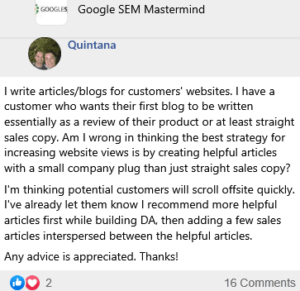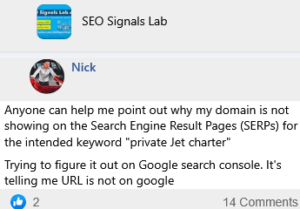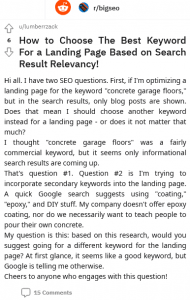Shadman
My gurus, can I be enlightened on transactional content. Literally couldn't Google it out.
Like an example, and any key secrets you may have to really get the most out of them.
Guys I need your expert opinion on the matter. Please Help.
📰👈
1 👍🏽1 filtered from 16 💬🗨
It sounds like some clever marketer has borrowed a phrase from the world of accounting – or simply came up with their own definition.
In a general sense, "transactions" are exchanges of value for value, such as information for compensation or something of comparable value.
In Web user behavior, a transaction occurs when the visitor engages with controls on a Website – such as leaving a comment, purchasing a product, filling out a form, etc.
In search engine optimization, a Transactional Query is one where the searcher's intent is to find content where they can engage in transactional behavior. That could be to purchase something, to subscribe to a newsletter or service, or to engage in online discussions.
Hence, by extension (and this is based only on a single Website I could find that uses the phrase "transactional content" in this way), Transactional Content is Web content that is designed to facilitate transactions (specifically commercial transactions such as paid subscriptions or purchases).
That is a very non-standard use of the phrase, but semantically it makes sense to me. Maybe it will catch on.
There is a rather old research paper titled "Website Evaluation and an Empirical study of Arabian Gulf Airlines" that provides a more restrictive definition for "Transactional Content" in the context of Website content/actions.
====== BEGIN CITATION ======
Transactional content is emphasized by Barnes and Vidgen [12] and Liu and Arnett [9] in their research instruments to
measure Web site quality. In this research, transactional content is measured by 14 factors:
• Search for ticket by date
• Search for ticket by price
• Seat map/selection
• On board services (Meal preferences, handicapped support, kids or infants help)
• Book a flight online
• Change ticket online
• Cancel ticket online
• View current flight booking
• Multicity booking
• Payment method (credit cards, cash, etc)
• Delivery of ticket (e-ticket, paper ticket)
• Online Boarding Pass
• Ability to use/choose city name instead of airport code when search/book fl ights
• Search fl ights within a range of time (+ or – 3 days, + or – 7 days. etc)
======== END CITATION ========
That paper is part of a small group of similar studies. Maybe the 1 Website I found that uses "Transactional Content" in an SEO/ecommerce context borrowed their definition from that.
Traditional business usage really doesn't have anything to do with ecommerce and Web content.
Thank you for the thorough brief.
So the term came to me through transactional keywords, which was advised to use to generate one of the 4 types of content marketing articles- navigational, info, branded, and transactional content.
The person who told me this had bad English, so i am assuming he meant to define articles based on transactional keywords w the term- transaction
My Query:
I wanted to know about e-commerce blog content that would drive sales. Like basic things like should I add a lotta buttoned Call-To-Action (CTA)s or should I keep the contents short, and what form of value should I provide to garner urgency in the visitors.
Michael Martinez 👑 » Shadman
"The person who told me this had bad English, so i am assuming he meant to define articles based on transactional keywords w the term- transaction
I agree with you.
Many things drive sales. The customer journey can be quite long. It begins with discovery that a product or service exists, continues into the realization that such a product or service may help fulfill a need, and then into research about products and services, cost comparisons, other questions that need to be answered, etc.
So a blog might address the customer journey at any of those points.
And once you begin thinking about the larger picture and how blogs can fit into it, you begin to ask questions about attribution and tracking. And I can tell you no one has solved that problem completely or concisely, although there are many creative approaches to addressing the need.
I would say, for the time being, that blog-based transactional content should be described as posts that complement product listing pages – with calls to action. Sort of like affiliate marketing blog posts, but published by the ecommerce site directly. At least, given the context of this conversation, that is I how I recommend you think about it.
Shadman ✍️ » Michael Martinez
Here's a rough sketch up of plan I'm thinking of, let me know what you think Boss:
1) Use a keyword that addresses a particular pain point w low Keyword Difficulty (KD).
2) Explain the product, their benefit, some bonus pain points they can fix w it.
3) Casually suggest my brand and tell em about our USP
4) place isolated Call-To-Action (CTA)s.
Question: Should I keep the article length short as long articles may end up increasing the bounce rate?
Michael Martinez 👑 » Shadman
I think you will benefit more from hearing other people's opinions. I hope a few people decide to comment.
Good luck.
💟1
Shadman ✍️ » Michael Martinez
For sure. Hence me questioning the group. I will be taking your initial advice into my implementation plan. Thanks again.
📰👈
Ammon Johns 👑
Many years ago, Google announced that of the millions of searches per day, 10% were Navigational, 10% were Transactional, and 80% were Information searches. It sounds as though someone may have gotten a garbled version of that, or misunderstood it.
Navigational searches are those ones that always used to perplex people in the days when we could see stats of actual searches done. A significant number of searches were ones where people would literally search for "" and similar. Navigational searches are where people already know the *specific site/page* they want, but use the search engine to get there, (possibly because they have the search engine as their homepage). This is roughly 10% of all searches made, and it can include just the obvious brand name Amazon, Apple, Microsoft, etc.
Transactional searches was misunderstood by many even back then. People thought this was all the shopping and ecommerce search, and some were surprised that all of that was less than 10% of all searches. But as Michael Martinez already explained, the term 'transaction' used by Google's IR scientists includes all sorts of transactions and interactions, where they are specifically looking to transact, or perform an action. Shopping, filling out forms of any kind, submitting posts, commenting, those are all 'transactional'. So all the searches that include an action word, such as buy, find, submit, upload, and such may be classed as transactional searches.
80% of search being informational, looking for information whether it be news, weather reports, reviews of a product or type of product, finding all of the window cleaners near your location, those are all informational.
So, when Google use the term, they mean any search that includes keywords relating to a transaction or an exchange, where the user will likely fill in a form of some kind, including a shopping cart processing form.
When SEO users use the words 'transactional' they might mean that there is an intent to purchase, hire, subscribe, etc. far more directly concerned with business transactions.
Amazon.com. Spend less. Smile more.
AMAZON.COM
Amazon.com. Spend less. Smile more.
💟👍🏽3
As always, thanks a million. This was PRECISELY what I wanted to find out. Like how I should go about creating the engagement. Forms, freebies, CTA-oriented texts, review, and versus contents are it.
Didn't think I was gonna find a solid answer cuz couldn't find it on google. Respect, my man.
Adam J. Humphreys 👑
Noah Learner often talks about this and how to segment it using Google Search Console's API. Some others have done similar.
🤯👍🏽2
Uh what exactly do you mean when you say GSC APIs?
Are these it?

Adam J. Humphreys 👑 » Shadman
The first one the second is experimental. You can also tie it into Google data studio. You get way more keyword data this way.
🤯1
Shadman ✍️ » Adam J. Humphreys
Yes I'm still in the midst of figuring out and mastering G analytics. I will move on G tag manager and g data studio. But thanks man.
Adam J. Humphreys 👑 » Shadman
Don't worry we are always learning. They keep changing the interface on us 😆
💟1
Shadman ✍️ » Adam J. Humphreys
I actually like the fact that Google is evolving at a constant pace. Makes me feel competent for being able to somewhat keep up w it.
📰👈
These may satisfy you:
» Optimization for Click Through Rate (CTR) by Ammon Johns’s Strategy
» 4 Common Mistakes I See People Make in Doing Keyword Research for SEO








